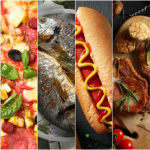 Food
Food  Food
Food  History
History 10 Odd Things Colonial Americans Kept at Home
 Weird Stuff
Weird Stuff 10 Superstitious Beliefs That Once Consumed Entire Cultures
 History
History 10 Bizarre Friendly Fire Incidents in Military History
 Technology
Technology 10 Modern Technologies That Accidentally Imitate Ancient Magic
 Mysteries
Mysteries 10 Mysteries of the Human Genome
 Weird Stuff
Weird Stuff 10 Things So Rare They’ve Only Been Found Once
 History
History 10 Legends Whose Last Moments Undid Their Glory
 Health
Health 10 Futuristic Ideas to Treat Common Medical Problems
 Weird Stuff
Weird Stuff Ten Surreal Attempts to Reverse Baldness
 Food
Food 10 Everyday Foods You Didn’t Know Were Invented by the U.S. Military
 History
History 10 Odd Things Colonial Americans Kept at Home
 Weird Stuff
Weird Stuff 10 Superstitious Beliefs That Once Consumed Entire Cultures
Who's Behind Listverse?

Jamie Frater
Head Editor
Jamie founded Listverse due to an insatiable desire to share fascinating, obscure, and bizarre facts. He has been a guest speaker on numerous national radio and television stations and is a five time published author.
More About Us History
History 10 Bizarre Friendly Fire Incidents in Military History
 Technology
Technology 10 Modern Technologies That Accidentally Imitate Ancient Magic
 Mysteries
Mysteries 10 Mysteries of the Human Genome
 Weird Stuff
Weird Stuff 10 Things So Rare They’ve Only Been Found Once
 History
History 10 Legends Whose Last Moments Undid Their Glory
 Health
Health 10 Futuristic Ideas to Treat Common Medical Problems
 Weird Stuff
Weird Stuff Ten Surreal Attempts to Reverse Baldness
10 Head-Scratching Food Fads That Have (Mostly) Come and Gone
There’s no question that food fads are fun to track. We’ve all seen it happen in real time. A certain food gets trendy, and BAM! It’s everywhere. Or perhaps a new style of food prep in restaurant kitchens takes hold. All of a sudden, a certain type of food or presentation is on every menu everywhere! That viral-ness of food fads has only increased in the modern world of social media, too.
But here’s the interesting thing: Food fads have been around for a long, long time. Way before social media, the internet, and mass communications technology at all! In this list, we’ll dive deep into ten fascinating tales involving food fads and when they occurred. These culinary trends popped up, spread across a region or country (or sometimes, the world), and then died out after a few years of a good run.
There’s no doubt you’ll be hungry as you read this list, so pack a snack before you scroll down.
Related: 10 Bizarre Foods from the Ancient World That People Still Eat
10 Syllabub (1750s)
Let’s start way, way back with our first food trend. In Colonial Williamsburg, Virginia, in the mid-18th century, people loved an after-dinner dessert called syllabub. To make it, you need wine, some type of acid, and heavy cream. Ideally, colonists would use lemons as the acid, add a little sugar, and drop in some Rhenish wine. Start with some cream in a bowl, whip it up by hand until it thickens, and then drop in the other ingredients. After a bunch more whisking, the dish ought to be getting thicker. From there, colonists would pour the whisked mixture into little glasses and let it sit somewhere cool overnight.
Obviously, they didn’t have refrigerators in Colonial Williamsburg. But any type of ice-filled chest would do the trick. That cool temperature allowed the mixture to set and separate—and turn into the perfect syllabub! The next day, residents could enjoy their perfectly mixed and separated syllabub to their heart’s content. It became a trendy after-dinner treat for folks in Williamsburg. The trend even carried on for decades after, though the 1750s were about the peak of its popularity. Think you’ve got the guts to try to whip up a batch right now?[1]
9 Congealed Salad (1930s)
The Great Depression was a tough time. There wasn’t any money, and so there wasn’t a lot of food to eat. Families had to get very creative about how they made meals. Cupboards were bare, and resources were slim! And you could forget about desserts. Well, unless you were down to eat a congealed salad, that is…
Today, we know this meal as “Jell-O,” but back in the 1930s, it was called a congealed salad. Basically, it was a hodge-podge of ingredients all mixed together and congealed until it was bouncing around on the plate. There were “exotic” recipes of cobbled-together ingredients like “Oriental Compote,” which included peaches, peach juice, cooked rice, and either lemon or orange Jell-O. “Spanish Jell-O Salad” contained pimentos, pickles, white cabbage, vinegar, and lemon Jell-O. All a hungry family had to do was set it and allow for some time to congeal.
Because the ingredient list was so flexible, families could make these congealed salads with nearly anything they had in their cupboard. And because so many families had very little money and very little joy, these treats provided some serious happiness. It wasn’t much, but there wasn’t much at all during the Great Depression. Naturally, congealed salads went “viral” long before going viral was a thing. Their popularity swept across Depression-era America and took hold in the public’s imagination. Truly, it was the little things![2]
8 Grass (1950s)
We all probably know a health nut or two who swears by wheatgrass shots. But seven decades ago, that was preempted by another weird health fad: grass. In 1956, a woman named Ann Wigmore founded something called the Hippocrates Health Institute. Wigmore and her institute believed that fully natural raw foods were the best thing to eat for one’s health. She even thought they could cure all kinds of diseases. So she opted to go for the most pure food of them all—wheatgrass—and promote it as a health food.
Americans in the post-World War II world didn’t know as much about nutrition as we do today, but for whatever reason, Wigmore’s teachings caught on. Nearly overnight through the late 1950s, she became a well-known health expert nationwide. She claimed that the common wheatgrass had all kinds of healing powers. She even told (obviously false) stories about how she’d seen wheatgrass fix soldiers’ broken bones as a young child during World War I. Uh-huh. Sure, Ann.
She took things a step further, too, by asserting that wheatgrass was the mystical “manna” described in the Bible. At that point, she went a little off the deep end. She began to refer to herself as Reverend Ann Wigmore and, years later, would claim that wheatgrass could cure cancer, arthritis, and even AIDS. Of course, it was all phony. But her wheatgrass push did turn into a serious fad for a long time among America’s nuttiest health nuts.[3]
7 Freeze-Dried Space Food (1960s)
Forget popularity throughout the world, food fads went to space in the 1960s! As the Space Race heated up, Americans became obsessed with how astronauts lived. One of the things that was most intriguing was how space residents ate while so far out of the planet’s orbit. Of course, they ate a lot of freeze-dried food. And quickly, that same food became faddish for Americans to eat down on Earth, just like the astronauts high above!
Shrewd marketers in the early 1960s realized that they could capitalize on all the attention brought to the Space Race. So they began freeze-drying and vacuum-sealing various foods and selling them as “out of this world” options to eat. Quickly, people bought into it… hook, line, and sinker.
Now, to be sure, freeze-dried foods pre-dated the Space Race. There are some benefits to freeze-drying certain foods, including the ability to make them more economical, efficient, and long-lasting. But the fad bubbled up through the 1960s because space was seen as such a cool thing. Everybody wanted to be like the heroic astronauts. So everybody wanted in on the action. Today, there are still freeze-dried foods around here and there, but the space-related marketing push has mostly died out. It’ll never quite be what it was like during the ’60s when the whole world wanted to eat like the astronauts.[4]
6 Dirt (1990s)
Yes, you read that right. But to be fair, we’re not talking about LITERAL dirt here. We’re talking about a trend that began in Denmark in the late 1990s and early 2000s. At a restaurant called Noma in Copenhagen, a chef named René Redzepi decided to experiment a bit. He put bits of dried malt on a plate and charred them with beer. He then brushed the whole concoction into a terracotta pot. And he called it… dirt. Because it looks exactly like dirt!
Redzepi’s idea was to use it as a garnish on certain high-end farm-to-table dishes that he was famous for concocting at Noma. In the years before that, he had drawn media attention for serving hand-picked flowers for dinner. He also caught local game himself and then cooked it for meals. So, when “dirt” came around, the food media was ready to pounce on the promo. And in time, fine diners from all over the world were flying into Copenhagen to try the new creation at Noma.
As we said, it wasn’t actual dirt being served. But that didn’t matter to the trendsetters and trend seekers who wanted to find the next big thing. In a way, Redzepi really started a long-lasting trend with a variety of the things he’s done. After all, even mid-scale eateries today boast of “farm-to-table” ingredients and locally sourced foods. That trend had to start somewhere. And it began thanks to the man who had his diners eating dirt for a few years there. Wild![5]
5 Cheese Tea (2000s)
Nowadays, it seems like milk tea is everywhere. Boba has taken America by storm. And that makes sense because it’s delicious! But that trend didn’t pop up recently. Long before milk tea was a thing, cheese tea was all the rage. And while it didn’t catch on quite as strongly in America, it was all over Asia through the early 2000s.
In that era, vendors in Thailand began selling cheese tea on the street. They would whip up cheese and put it on top of iced tea. Some of the drinks got remarkably complicated and included things like matcha, oolong, and a foamy topped mixture of salt, milk, whipped cream, and even cream cheese. (Yes, really.) As the trend grew, other vendors tried to add things like chocolate, green tea, fresh fruit, and even crumbled Oreo cookies.
Through the latter half of the 2000s, cheese tea spread in popularity from Thailand to Singapore, China, Japan, and even Malaysia. It was exported to the United States and the United Kingdom, too, but it never quite took hold. It still has popular variants in other countries, though! In Finland and Sweden, locals drink a beverage called “kaffeost.” That’s a hot coffee drink garnished with a cheese cube floating in the cup. In Colombia, residents often stir white cheese into their hot chocolate to create a concoction known as “chocolate santafereño.” So the cheese tea fad has indeed gone global![6]
4 Naked Sushi (2000s)
Okay, so this one isn’t a trend about the food itself but the way it is served. In the 2000s, food culture felt like getting a bit risqué. In Japan, in particular, the desire to push the boundaries of service and restaurant life was very strong. So some restaurants started putting naked models down on tables (like real-life women!) and serving sushi right on top of them! Dinner guests would come into the restaurant, sit down at the table, and be presented with a completely naked, perfectly still woman to eat off of.
The practice was known as “nyotaimori” in Japanese, which quite literally translates to “female body arrangement.” And arrange, they did! Guests would take their chopsticks and carefully (well, we hope they were careful) pick pieces of sushi off the women before them. Can you imagine the dinner conversations that would have been held at those meals?!
Unfortunately (or maybe fortunately), the “nyotaimori” trend didn’t really take hold very much outside of Japan. High-end restaurants in Europe and America have tried it, and some still do things like that from time to time. But it was mostly a Japanese phenomenon that really bubbled up in the 2000s. Still, we would have liked to have experienced one meal like that. Just one. For, uh, research. Yeah… research.[7]
3 Deep-Fried Everything (2010s)
While naked sushi was a thing in Japan, the next food fad to take hold in the United States was about as unsexy as one could get. Rather than go clothes-off and make it hot, the U.S. opted to go for a deep-fried fad that just made us all fat. Through the 2010s, deep-fried food was absolutely everywhere across America. Not just in the Deep South, where it had been a staple for decades. And not just things like deep-fried chicken, which by then was obviously commonplace. We’re talking much weirder than that!
The trend bubbled up in state fairs and county fairs alike throughout middle America. Food booths at these events and plenty of others sold deep-fried crocodiles, starfish, tarantulas, and more. The cooking oil was easy to come by, and frying pretty much anything guaranteed that it would taste good.
Plus, since viral news on the internet was first really starting to take hold in the 2010s, that made the marketing for these deep-fried concoctions pretty easy and straightforward! By the 2010s, media outlets had figured out there was an audience for weird food news. They would cover county fairs and document the strange deep-fried creations. In turn, this made people want to try more and more deep-fried foods. And suddenly, a trend was born!
It helped that deep frying is a pretty simple process. Dangerous, sure, but it’s easy to come by the ingredients and set up a vat to do the duty. Soon, pretty much everything was being dropped into the frying oil. Hollywood even got in on the game a bit, too! Television shows through the 2010s had whole episodes dedicated to the fad of deep-frying food and making light of just how gluttonous that trend had become. And when TV writers pick something up, you know it’s a fad destined to soon run its course![8]
2 Freakshake (2010s)
The deep-fried fad was only the beginning of the gluttony of the 2010s. Later that decade, the so-called “freakshake” emerged as one of the trendiest and most disgusting foods to ever come along. Basically, a freakshake is a milkshake on steroids. It’s got every possible sweet you can imagine all jammed up inside it. Cookies, chocolate, pieces of cake, candy bar pieces, waffle cone bits, and everything else, mixed in with a shake and topped with whipped cream and sprinkles. (Because of course.)
But here’s the crazy thing: it’s actually not an American concoction! You would have been understandably correct to assume that the Yankees came up with the freakshake, but it was actually first created Down Under. That’s right—the Australians are on the hook for this absolutely disgusting monstrosity. Cover it with as many bits of sweets as you possibly can, export it all around the globe, and bam! Everybody gets diabetes.
As you can probably imagine, these freakshakes get extremely messy. And as you can also probably imagine, they are not made to be consumed as food quite as much as they are made to be photographed and posted on social media. You make a freakshake at some store, you post the picture and spend your money on it, and then somebody else sees it and comes in later to do the same thing. The whole economy is propped up by these damn freakshakes! Okay, that’s a little bit of a stretch. But that fad was pretty disgusting.[9]
1 Glitter Cappuccino (2010s)
Let’s round out our look at food trends with one more story about a fad that swept across social media: glitter cappuccinos. In 2017, news outlets began to cover the very shiny phenomenon. It kicked off in coffee houses in Mumbai, India. The first place that was really documented pulling off the glitter cappuccino was a cafe called Coffee by Di Bella. But again, social media was instrumental in spreading this fad far and wide. Before long, Americans and Europeans alike were adamant that they wanted glitter to be sprinkled atop their coffee drinks.
And before long, coffee makers and baristas got very good at making their glittery concoctions into complicated designs. Gold and silver glitter would be spread across a frothy cappuccino in very intricate patterns. The presentation was immaculate, cool, and extremely Instagram-worthy. So it’s no wonder that the trend spread all over the world in only a few short months and took hold with the influencer crowd. Everybody likes pretty things!
But what about, you know, actually drinking that glitter? It was there that consumers first began to balk. Food scientists quickly started piping up with concern that a lot of the glitter being used at coffee shops for this fad may not be safe to drink. What seemed innocent at first was suddenly a potentially dangerous activity. “It could be that this stuff is inert and passes through your body,” one food science expert said of the sparkly trend in a 2018 interview. “The more nuanced answer is we don’t know about the safety of this. This is putting something in your body that is not designed as food. I can’t recommend it.” Oof. Pretty scary. We’ll pass on this fad, thanks![10]








